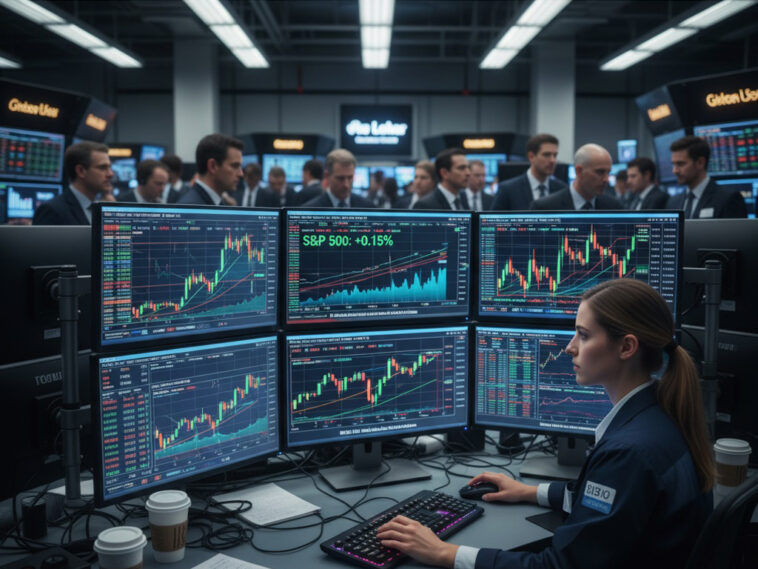The PCE inflation index, which the Federal Reserve relies on to gauge price pressures, brought a brief moment of relief for investors on Friday. U.S. stocks mostly ticked up, with the Dow Jones Industrial Average taking the lead, as the crucial August data matched economists’ predictions perfectly. However, it was a narrow victory for the bulls, as the market also had to contend with a new wave of tariff threats from President Trump and a surprisingly gloomy report on consumer sentiment.
The Dow Jones Industrial Average (^DJI) saw a gain of about 0.4%, a solid move considering the surrounding uncertainty. The broader S&P 500 (^GSPC) also ended on a positive note, rising by 0.15%. On the other hand, the tech-heavy Nasdaq Composite (^IXIC), which has been feeling the pressure lately, couldn’t maintain its footing, dropping 0.16% after a challenging three-day period for the major indexes.
Core PCE Hits Forecasts, But Prices Remain Sticky
The early morning update came straight from the Bureau of Economic Analysis. The “core” PCE inflation price index, which excludes the often unpredictable food and energy prices and is closely monitored by Fed officials, saw a year-over-year increase of 2.9% in August. On a month-to-month basis, it registered a modest 0.2%. Importantly, both of these numbers matched what analysts had anticipated.
While hitting these expectations is a positive sign for market stability, there’s no reason to pop the champagne over inflation just yet. “Just meeting a consensus estimate means that things didn’t get worse than we thought, not that they’re actually improving,” pointed out Veronica Silva, Chief Economist at Blackwood Capital. “We’re still significantly above the Fed’s 2% target. Inflation is proving to be a stubborn issue, like old chewing gum stuck to the sidewalk.”
Tariff Treachery Targets Pharmaceuticals and Trucks
Just when investors were starting to digest the latest inflation figures, another storm brewed on the trade front. Late Thursday, President Trump took to social media to issue a bold threat: a staggering 100% tariff on imports of branded drugs. He asserted that this hefty tax would hit any pharmaceutical company that wasn’t actively setting up a manufacturing plant in the U.S. As is often the case with such announcements, the specifics were pretty thin.
The impact was swift and, frankly, predictable: shares of major drug companies in Europe and Asia took a hit following the news. This latest trade move adds yet another layer of geopolitical uncertainty for markets that are already grappling with the durability of the recent A.I. surge and the high-stakes standoff over a potential U.S. government shutdown. On a related note, imports of heavy trucks and certain types of furniture are also bracing for new, higher tariffs starting October 1st. Talk about giving businesses a tight timeline!
Consumer Mood Darkens as TikTok Saga Stumbles
The late-morning trading session saw stocks retreat from their earlier highs, largely due to the gloomy sentiment reflected in the latest survey from the University of Michigan. It seems that Americans are feeling surprisingly downbeat about the U.S. economy this September. This is a crucial factor: if consumers—the driving force behind the economy—start to feel anxious, it can quickly lead to reduced spending and slower growth.
On another note, the ongoing saga surrounding TikTok’s operations in the U.S. continues to puzzle Wall Street. The President has signed off on a deal to separate the U.S. segment from China’s ByteDance, but we’re still waiting for the final nod from Beijing. The proposed $14 billion price tag has certainly raised eyebrows. “That valuation is puzzling,” remarked Marcus Chen, a seasoned tech analyst at Trident Securities. “We’re talking about a global social media giant that many estimates had valued closer to $40 billion. This lowball figure just screams uncertainty and hasty negotiations.”
In the end, the S&P 500 is on track for what would be its first weekly loss this month, indicating a much-needed cooling-off period after a strong, record-breaking summer rally. Investors, having successfully navigated a predictable inflation report, now need to adjust to the realities of escalating trade wars and a noticeable dip in economic optimism. It’s a tricky situation, where even the smallest piece of unexpected news—whether positive or negative—could lead to a significant market shift. In short, the market is teetering on a knife’s edge.



